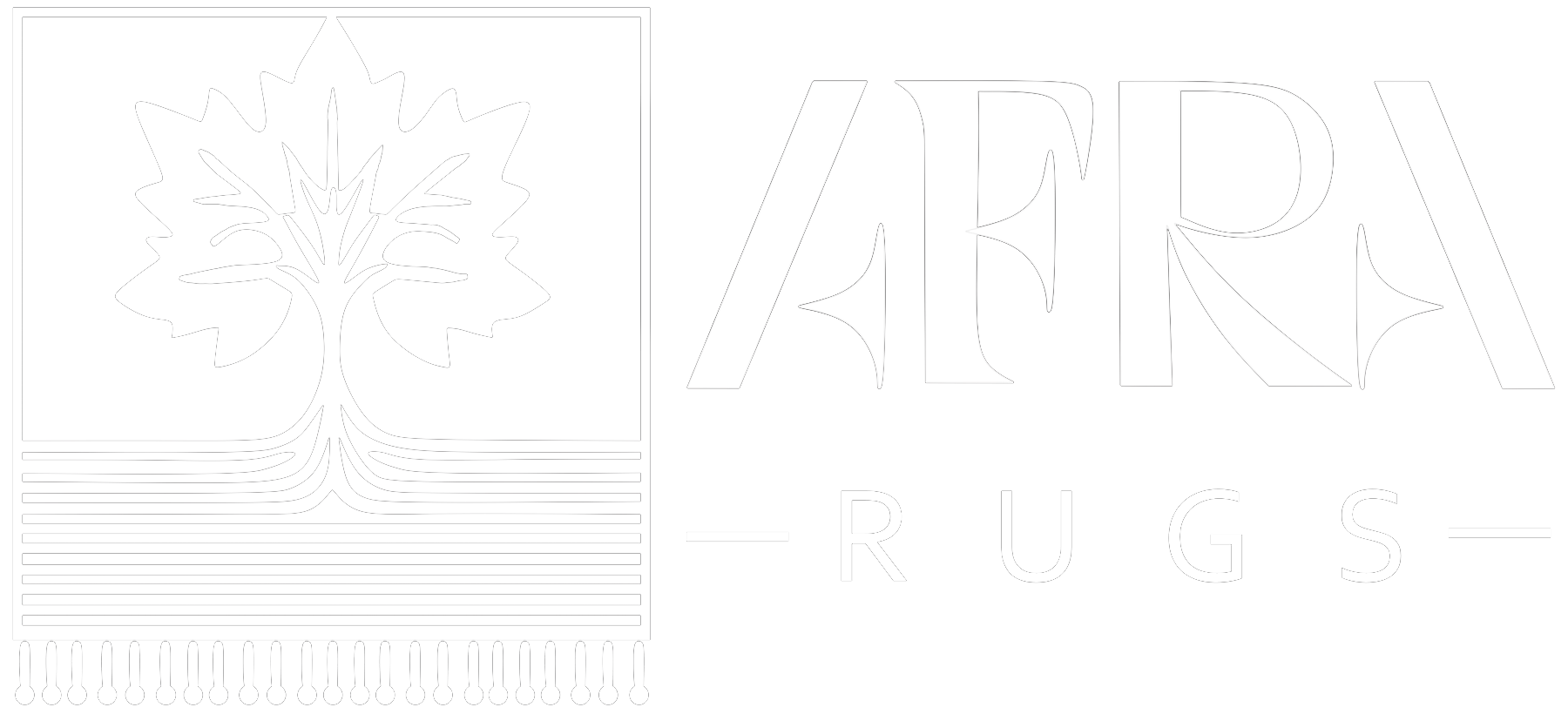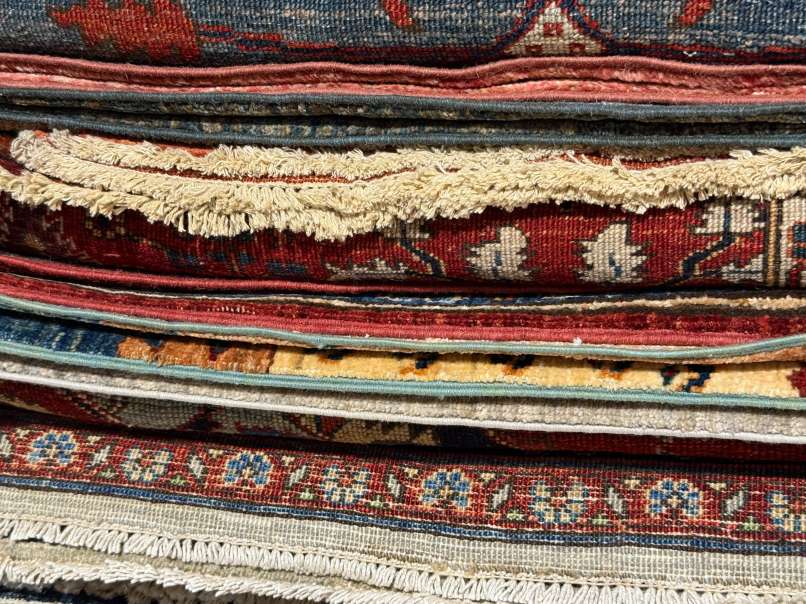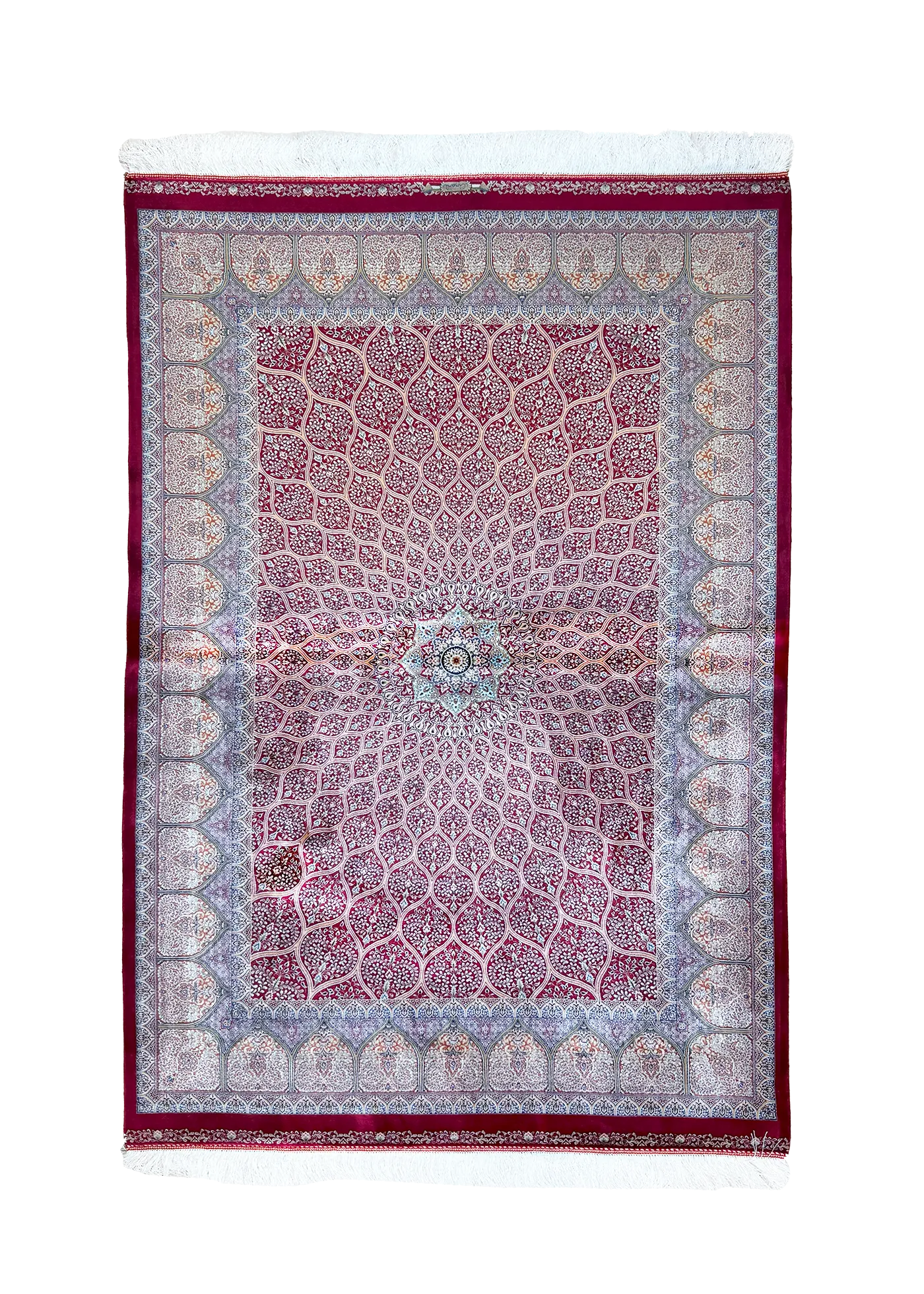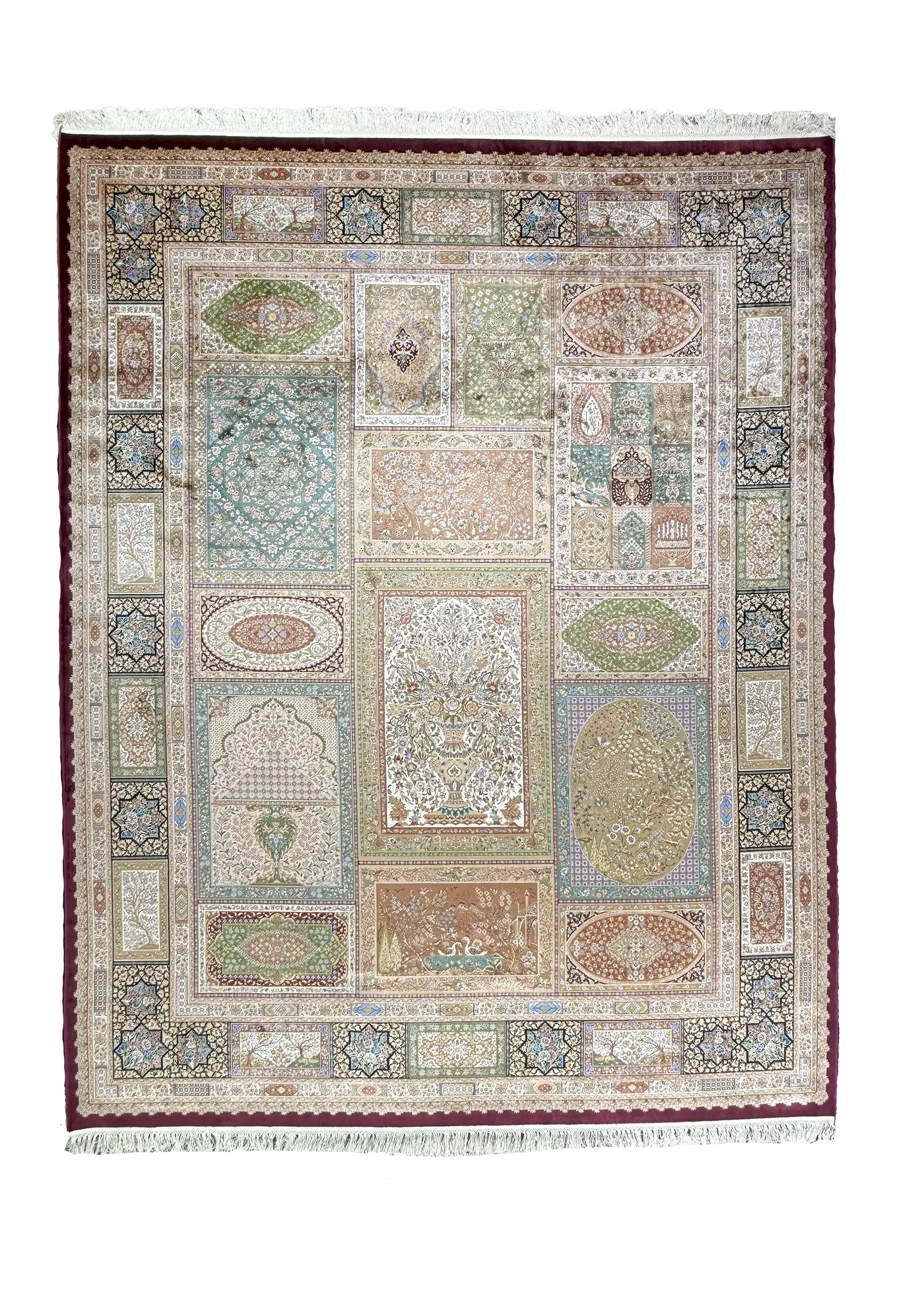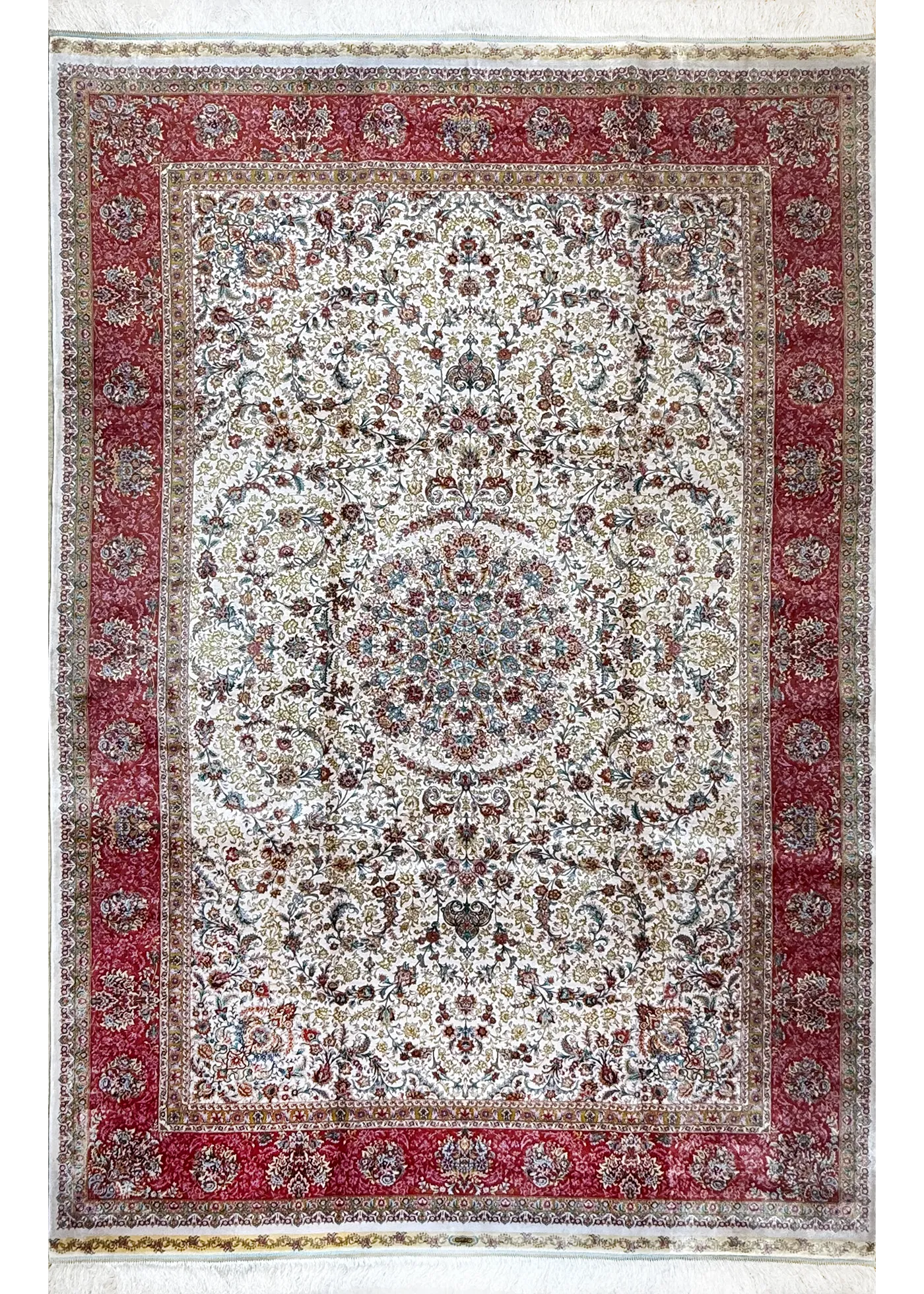Answering Your Top 10 Questions About Persian Rugs
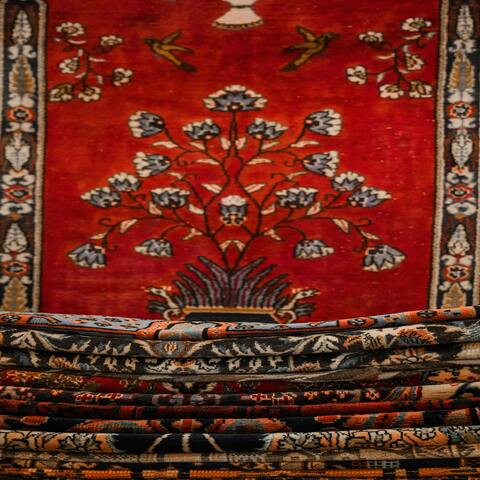
- 1 Red and Blue Persian Rug Vanda Pattern 5 x 8
- 2 Why Persian Rugs Captivate the World
- 3 History and Craftsmanship of Persian Rugs
-
4
Top 10 Questions About Persian Rugs (FAQ)
- 4.1 1. What Makes Persian Rugs Unique?
- 4.2 2. Are All Persian Rugs Hand Woven?
- 4.3 3. What Is the Importance of Knots per Square Inch?
- 4.4 4. How Long Do Persian Rugs Last?
- 4.5 5. What Types of Materials Are Used in Persian Rugs?
- 4.6 6. What Are the Most Common Patterns in Persian Rugs?
- 4.7 7. Do Colors Matter?
- 4.8 8. Are Persian Rugs Considered Works of Art?
- 4.9 9. How Can You Tell if a Rug Is Authentic?
- 4.10 10. Should I Buy a Machine Made Rug or Hand Woven?
- 5 Regional Styles and Iconic Designs
- 6 Care and Maintenance Tips
- 7 Conclusion
Discover answers to the top 10 questions about Persian rugs, from floral patterns to high knot density.
Why Persian Rugs Captivate the World
A Persian rug holds a certain magic. A room with a Persian rug evokes centuries of history beneath your feet. The colors, patterns, and textures tell a story. Each thread carries tradition, skill, and artistry.
From deep red tones to delicate floral motifs, Persian rugs are more than decoration they are works of art.
Many wonder what makes Persian rugs exceptional and how to verify their authenticity. These are common questions about Persian rugs, and for good reason. A single rug can carry centuries of craftsmanship.
Some pieces last 100 years or more. The right rug can transform a home. It can be a centerpiece, a conversation starter, or even a family heirloom.
Exploring oriental rugs? Considering a hand woven piece? Learning the difference between natural and synthetic dyes? Understanding these rugs is essential.
In this guide, we will answer the top 10 questions about Persian rugs in detail. We will explore patterns, materials, colors, and care. You will also learn how knots per square inch affect the rug’s beauty and durability.
Along the way, we will explore regional styles and highlight iconic motifs. We will also show why a high quality Persian rug stands as a true work of art. By the end, you will know how to appreciate these treasures, and how to choose one for your space. Now, we begin our journey into the world of Persian rugs.
History and Craftsmanship of Persian Rugs
Ancient Origins
Persian rugs have a history that spans centuries. They originated in the Persian Empire, where artisans transformed threads into stories. The rugs were functional, providing warmth, but also symbolic. Each design element had meaning. A central medallion might represent the universe. Floral patterns could symbolize gardens, life, and growth. Geometric patterns often indicated order and harmony.
Over time, certain regions became famous for their distinctive styles. Kashan, Tabriz, Isfahan, and Qom are among the most celebrated. Each area developed signature designs, reflecting local culture and traditions.
Materials: Wool and Silk
High quality Persian rugs are typically made of wool or silk. Wool is soft, durable, and resilient. Silk adds sheen and allows for higher detail. Silk rugs can feature high knot density, making intricate floral motifs and delicate geometric patterns possible. These materials also influence the rug’s longevity. With proper care, a rug can last 100 years or more.
Dyes: Natural vs Synthetic
Color is another critical aspect. Natural dyes are made from plants, insects, and minerals. They produce rich, subtle tones that age gracefully. For instance, a deep red from natural dye may mellow beautifully over decades. Synthetic dyes offer consistency and brightness but can sometimes fade unevenly. When buying a high quality Persian rug, checking the type of dye is essential.
Knots per Square Inch (KPSI)
One of the most important features is knots per square inch. More knots mean more detail and durability. Rugs with high knot density can display complex floral patterns, geometric patterns, and central medallions with clarity. Lower knot counts are faster to make but less intricate. Whether hand woven or machine made rugs, KPSI indicates quality and potential longevity.
Table: Key Features of High Quality Persian Rugs
| Feature | Description | Importance |
|---|---|---|
| Materials | Wool or silk | Determines texture, durability, and shine |
| Dyes | Natural dyes, synthetic dyes | Affects longevity, color depth (e.g., deep red) |
| Knot Density | High knot density per square inch | Allows intricate designs and smooth texture |
| Patterns | Floral patterns, geometric patterns, central medallion | Cultural symbolism and aesthetic appeal |
| Age | Up to 100 years | Collectibility and investment potential |
This table helps you understand what makes a high quality Persian rug. Ensuring the rug meets these standards guarantees a piece that is both beautiful and durable.
Top 10 Questions About Persian Rugs (FAQ)
Here are the most common questions about Persian rugs. Each answer is detailed and practical.
1. What Makes Persian Rugs Unique?
Persian rugs are unique because they combine artistry, craftsmanship, and culture. They feature central medallions, floral motifs, and geometric patterns. The materials, whether wool or silk, add texture and shine. The use of natural dyes provides depth and lasting color. Finally, high knot density ensures intricate detail, making each rug a work of art.
Even in modern times, some machine made rugs mimic these features, but nothing compares to the richness of a hand woven rug.
2. Are All Persian Rugs Hand Woven?
No. Traditional Persian rugs are hand woven, which gives them unique character. Small variations in knots and patterns reflect the artisan’s skill. Machine made rugs exist as well. They are more uniform and affordable, but they lack the subtle irregularities that make a hand woven Persian rug special.
For collectors, authenticity and craftsmanship matter. High quality Persian rugs with hand woven construction maintain value and beauty for decades.
3. What Is the Importance of Knots per Square Inch?
Knots per square inch (KPSI) measure detail. A rug with more knots can feature intricate floral patterns and complex geometric patterns. High KPSI also improves durability. For example, a rug with high knot density will resist wear and retain its central medallion clarity for years.
Even small differences in KPSI affect texture and design. Always check this when choosing a high quality Persian rug.
4. How Long Do Persian Rugs Last?
With proper care, Persian rugs can last 100 years or more. Factors like material, knot density, and dye type affect longevity. Hand woven rugs made from wool or silk with natural dyes typically age gracefully. Machine made rugs may have shorter lifespans but can still be beautiful.
Proper placement, avoiding direct sunlight, and regular cleaning are essential. Ensuring the rug is well-maintained preserves both color and structure.
5. What Types of Materials Are Used in Persian Rugs?
Most authentic Persian rugs use wool or silk. Wool is soft and resilient. Silk allows for high knot density, creating detailed floral motifs and precise geometric patterns. Some rugs blend wool and silk for durability with delicate design.
The choice of material influences texture, shine, and longevity. High quality materials are a hallmark of lasting beauty.
6. What Are the Most Common Patterns in Persian Rugs?
Patterns define a rug’s character. Common designs include:
- Floral patterns: Represent gardens, life, and harmony.
- Central medallion: The focal point, often surrounded by borders.
- Geometric patterns: Repeating shapes symbolizing order.
Colors like deep red complement these patterns, highlighting intricacy and elegance.
7. Do Colors Matter?
Yes. Colors communicate mood and style. Natural dyes produce soft, layered tones. Synthetic dyes are brighter but may fade unevenly. Popular shades include deep red, gold, and blue. Proper care preserves the richness of these hues, maintaining the rug as a work of art.
8. Are Persian Rugs Considered Works of Art?
Absolutely. The combination of hand woven craftsmanship, high knot density, floral motifs, and geometric patterns makes each rug a work of art. They are admired for beauty, cultural significance, and technical skill.
Even machine made rugs strive to replicate these qualities, but the authenticity and artistry of hand woven Persian rugs remain unmatched.
9. How Can You Tell if a Rug Is Authentic?
Authenticity is crucial when it comes to Persian rugs. An authentic rug is not only visually stunning but also a reflection of centuries-old craftsmanship. There are several key indicators to help you determine whether a rug is genuinely hand woven and meets traditional standards.
Hand Woven Construction: One of the most obvious signs of authenticity is that the rug is hand woven. Each knot is tied individually by skilled artisans, which allows for subtle variations in the pattern. These minor irregularities in symmetry or knots are not flaws they are evidence of genuine craftsmanship. Unlike machine made rugs, which are perfectly uniform, hand woven Persian rugs have a unique character and individuality.
High Quality Wool or Silk: The materials used are another important clue. Authentic Persian rugs are typically crafted from wool or silk, or a combination of both. Wool provides durability and softness, while silk adds sheen and allows for extremely fine detailing. These materials also help the rug age gracefully over decades. For example, a rug made with high-quality silk threads can maintain the vibrancy of its deep red or pastel tones for many years, especially when natural dyes are used.
Subtle Irregularities in Knots: As mentioned, consistent yet subtle irregularities in knots are a positive sign. They indicate that a human hand, rather than a machine, shaped the rug. Experienced buyers often run their fingers over the back of the rug to feel the density and consistency of the knots. Variations in tension or knot placement are hallmarks of a hand woven masterpiece.
Design Features: Authentic rugs often feature key elements like a central medallion, delicate floral motifs, and precise geometric patterns. These designs are not only aesthetic choices they carry cultural significance and are indicative of specific regional traditions. For example, a rug from Kashan might have a central medallion surrounded by ornate floral patterns, while a Tabriz rug might combine geometric patterns with naturalistic floral motifs.
Colors and Dyes: Color is a telltale sign of authenticity. Rich, age appropriate colors achieved with natural dyes show depth and subtle variation. Over time, natural dyes develop a patina that adds character and warmth, unlike synthetic dyes that may fade unevenly or appear too bright. A properly dyed authentic Persian rug will age gracefully, often gaining more charm and character over decades.
Regional Markers: Many authentic Persian rugs carry regional markers in style and pattern. Whether it’s the intricate floral designs of Isfahan, the bold deep red of Kerman, or the delicate central medallions of Kashan, these regional signatures help identify a rug’s origin and authenticity.
In summary, to identify an authentic Persian rug, check for hand woven construction, high quality materials, subtle knot irregularities, signature designs, and natural, age appropriate colors. Doing so ensures that you are investing in a work of art that can last a lifetime and beyond.
10. Should I Buy a Machine Made Rug or Hand Woven?
Deciding between a machine made rug and a hand woven Persian rug depends on your goals, budget, and appreciation for craftsmanship. Both have their place, but understanding the differences is essential.
Machine Made Rugs: These rugs are made using automated looms. They offer consistency and affordability, making them ideal for decorative purposes or temporary use. Machine-made rugs are uniform in design and knot density, which some people prefer for modern minimalist interiors. However, they generally lack the subtle variations, texture, and long term value of a hand woven Persian rug.
Hand Woven Persian Rugs: For those seeking artistry, investment, and durability, hand woven rugs are unmatched. They offer:
- Intricate floral patterns: Every flower, leaf, and vine is carefully placed by skilled artisans.
- High knot density: Ensures detailed designs, clarity in central medallions, and overall durability.
- Rich colors: Often featuring deep red, soft blues, and other natural hues that develop a beautiful patina over time.
- Cultural and artistic value: Each rug is a miniature work of art representing centuries of tradition.
Collectors often prefer hand woven rugs because they maintain their value over decades and sometimes even appreciate. For long-term investment, a hand woven Persian rug made from wool or silk and dyed with natural dyes is ideal. Machine made alternatives may look beautiful initially but rarely match the artistry, texture, or longevity of authentic Persian rugs.
- Final Consideration: If your goal is a lifelong investment, aesthetic elegance, and cultural authenticity, a hand woven rug is the way to go. If affordability and uniformity are priorities, machine made rugs serve their purpose. However, when choosing a rug, remember that authentic Persian rugs offer a unique experience, combining heritage, beauty, and durability that a machine made rug cannot replicate.
Related articles:
Regional Styles and Iconic Designs
Persian rugs are not all the same. Their style, design, and craftsmanship vary depending on the region where they are made. Each area has a long tradition of rug weaving, often spanning hundreds of years, and their patterns reflect local culture, history, and artistic preferences. Understanding these regional differences can help collectors, enthusiasts, and homeowners choose the right Persian rug for their space. Below, we explore the most celebrated regions, their signature styles, and what makes each one unique.
Kashan Rugs
Kashan, located in central Iran, is famous for producing some of the most elegant Persian rugs. These rugs are known for their fine detail, refined craftsmanship, and delicate floral motifs. One of the signature features of Kashan rugs is the central medallion, which acts as the focal point of the design. This medallion is often surrounded by intricate, symmetrical floral patterns that draw the eye outward to the borders.
Colors in Kashan rugs tend to be classic and rich. Deep red is commonly used for the central field, providing a striking backdrop for ivory, gold, and soft blue highlights. The borders often incorporate complementary colors, creating balance and harmony.
Many Kashan rugs are crafted from high-quality wool or silk, which allows for high knot density and very fine detail. This makes them durable while maintaining their aesthetic appeal for 100 years or more if properly cared for.
Kashan rugs are versatile they can complement traditional interiors with antique furniture or serve as a striking contrast in modern spaces. Collectors often seek Kashan rugs because their hand woven craftsmanship, floral motifs, and central medallion designs embody the classical elegance of Persian artistry. Each piece is a miniature work of art, representing decades of regional weaving expertise.
Tabriz Rugs
Tabriz, located in northwest Iran, is another center of rug excellence. Tabriz rugs are celebrated for their intricate geometric patterns combined with naturalistic floral motifs. Unlike the more symmetrical designs of Kashan, Tabriz rugs often incorporate a variety of decorative elements within a single piece, showcasing the versatility and creativity of the weavers.
One hallmark of Tabriz rugs is the use of silk highlights, which enhance the sheen of certain areas, particularly around the central medallion or the intricate floral motifs. The weavers here have mastered both balance and symmetry, ensuring that even complex compositions feel harmonious and elegant.
Color palettes in Tabriz rugs are diverse but usually include softer tones like ivory, blues, and pastel shades, along with striking accents of deep red. The combination of high quality wool or silk and high knot density allows for incredibly detailed patterns, where even the smallest flower or leaf is rendered with precision. Because of these qualities, Tabriz rugs are often considered collectible and valuable additions to any interior.
Isfahan Rugs
Isfahan, located in central Iran, produces some of the most luxurious Persian rugs in the world. These rugs are known for their small scale, intricate designs, which often feature delicate floral motifs, fine geometric patterns, and central medallions. Isfahan rugs are usually smaller than Kashan or Tabriz rugs but are extremely detailed and highly collectible.
The materials used in Isfahan rugs are typically high quality silk or wool, ensuring a soft, lustrous finish. Colors are rich but balanced, with ivory, beige, and deep red tones appearing frequently. The patterns often include intertwined flowers, vines, and occasionally birds, creating a miniature tapestry effect. Many collectors value Isfahan rugs for their elegance and ability to transform a room into a sophisticated space.
Because of their detailed craftsmanship, Isfahan rugs often require more time to produce. Some can take several months to a year to complete. Their high knot density and meticulous hand woven construction mean they can last for 100 years or more, aging beautifully over time. Owning an Isfahan rug is like owning a small piece of art history.
Other Regional Highlights
While Kashan, Tabriz, and Isfahan are among the most famous, several other regions contribute uniquely to the rich tapestry of Persian rugs.
- Qom Rugs: Known for their fine silk and extremely detailed designs, Qom rugs are often luxurious and collectible. They frequently feature floral motifs, central medallions, and intricate borders. The fine silk allows for incredibly high knot density, resulting in crisp, miniature details.
- Nain Rugs: These rugs are lighter in color, often using ivory or cream backgrounds with subtle floral motifs. Nain rugs are elegant and understated, perfect for creating an airy, refined atmosphere. Their geometric patterns are subtle but precise, and the use of high quality wool or silk ensures durability.
- Kerman Rugs: Kerman rugs are famous for their rich deep red tones and wide variety of patterns. They often combine floral motifs with geometric patterns in intricate, layered designs. Kerman weavers also experiment with color harmonies, balancing bold tones with softer shades. These rugs are versatile, appealing both to collectors and to homeowners seeking a statement piece.
Each of these regions brings something unique to the world of Persian rugs. Whether it’s the luxurious silk of Qom, the light elegance of Nain, or the bold deep red patterns of Kerman, regional styles reflect centuries of craftsmanship, local culture, and artistic expression. By understanding these distinctions, you can appreciate the beauty and history woven into each rug and make informed choices when selecting an authentic Persian rug for your home.
Care and Maintenance Tips
To preserve your Persian rug:
- Rotate regularly to avoid uneven wear.
- Keep out of direct sunlight to protect natural dyes.
- Vacuum gently to avoid damaging high knot density areas.
- Treat spills immediately.
- Use professional cleaning periodically.
Proper care ensures your rug remains a work of art and can last 100 years. For inspiration, see our Traditional Persian Rugs Collection for high quality Persian rugs that combine beauty and durability.
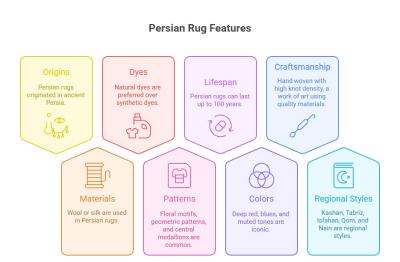
Conclusion
Persian rugs are timeless treasures. They combine hand woven craftsmanship, high quality materials, intricate floral motifs, and geometric patterns. Proper care ensures longevity, allowing a rug to last 100 years or more. Understanding questions about Persian rugs, including knots per square inch and natural vs synthetic dyes, helps you choose wisely.
A high quality Persian rug with a central medallion, deep red tones, and authentic design is more than decoration it is a work of art. Explore our Traditional Persian Rugs Collection to discover luxurious options that bring beauty, history, and craftsmanship into your home.
